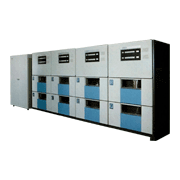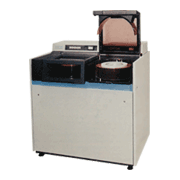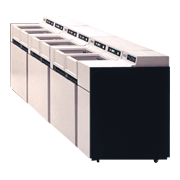The FACOM 477A was a grouped disk pack unit from Fujitsu equipped first with a command retry function and ECC function. It was completed in 1972.
The FACOM 477A disk pack unit was developed by making dramatic performance improvements to the previous FACOM 472L-- namely, increasing memory capacity, reducing access time and increasing data transfer speed. Furthermore, the following new functions were developed using the FACOM 1771A and FACOM 1771B disk pack controllers for controlling the FACOM 477A.
- 1) Multiple-request function using a rotation position detection mechanism
- 2) Command retry function
- 3) ECC function
- 4) Maintenance and diagnostic functions
The FACOM 1771A/B-FACOM 477A subsystems were connected to the block multiplexer channel (BMC) of the host system. These functions became the basis of technology for realizing later high-performance and high-reliability disk subsystems.
In 1975 Fujitsu developed the FACOM 478A2 disk pack subsystem based on these technologies. This subsystem maintained performance and reliability while dramatically improving cost performance. The FACOM 478A2 used a structure where two drives were arranged horizontally in the cabinet, thereby eliminating the need for the automatic pull-out mechanism required for vertical dual structures like those in the FACOM 477A. This made it possible to realize both economy and reliability, and achieve miniaturization and lighter weight. The grouped type was used with the previous 477A, but the individual cabinet system was used for the FACOM 478A2 and subsequent models to facilitate expansion.
In 1976 Fujitsu completed the FACOM 479B2 which improved track density from the previous 192TPI to 370TPI, and expanded memory capacity of each pack to 200Mbyte.
There were two implementations of the disk media and the access head. One was the replaceable type which was used with the FACOM 477/478/479, and another was the non-replaceable type which incorporated the disk media and the head into an all-in-one unit. But later magnetic disks for large general-purpose computers switched to non-replaceable type only, and the FACOM 479B2 became the final replaceable disk pack unit.
| (Reference) FACOM 472L |
FACOM 477A |
FACOM 478A2 |
FACOM 479B2 |
||
|---|---|---|---|---|---|
| Completion date | 1971 | December 1973 | October 1974 | August 1975 | |
| Equipment type | Grouped | Individual | |||
| Memory capa -city |
Track capacity |
7,294byte | 13,030byte | ||
| Pack capacity |
58Mbyte | 100Mbyte | 200Mbyte | ||
| Unit | 116Mbyte | 200Mbyte | 400Mbyte | ||
| Subsystem | 466Mbyte (8spindles) |
800Mbyte(8spindles)/ 1600Mbyte(16spindles) |
12.8Gbyte (64spindles) |
||
| Disk pack |
Number of tracks/ cylinder |
40 | 19 | ||
| Number of cylinders/ pack |
200+3(spare) | 404+7(spare) | 808+7(spare) | ||
| Number of tracks/disk side | 406 | 411 | 815 | ||
| Number of disks | 13 | 12 | |||
| Effective number of sides | 20+1(servo) | 19+1(servo) | |||
| Diameter | 17inch(430mm) | 14inch(356mm) | |||
| Positioning time | Average 50ms (Min. 15 ms,Max. 80 ms) |
Average 25ms (Min. 6ms,Max. 45ms) |
|||
| Rotation speed | 2,400rpm | 3,600rpm | |||
| Average rotational delay |
12.5ms | 8.4ms | |||
| Data transfer speed | 312Kbyte/s | 806Kbyte/s | |||
| Recor -ding density |
Linear density |
2,200BPI | 4,040BPI | ||
| Track density | 127TPI | 192TPI | 370TPI | ||
| Main connected systems |
*1 | ||||
*1:·Fixed length type: FACOM 230-35
·Variable length type: FACOM 230-45S/55, FACOM 230-60, FACOM 230-75




